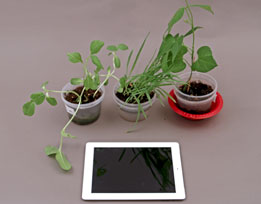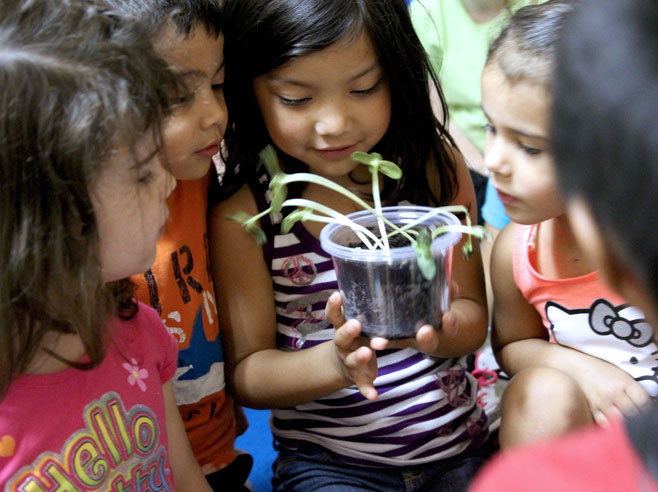Children look at their seeds and plants and view the Sprouting Seeds Photo Album and the Growing Graph as they reflect on how their bean plants have grown and changed and what they have learned in this Plants unit.
Materials

- Plants Journal app on the iPad designated specifically for Guided Small Group work
- Projector (if available)
- Bean seeds and plants
- Class Garden seeds and plants
- Optional: A fruit or vegetable
- Optional: A picture book about plant parts
Preparation
- Preview the photos in the Compare Class Plants section of the digital Plants Journal and find five to eight interesting photos from any group’s journal that show seeds and plants at different stages of development.
- Display the plants and seeds so children can see them during the discussion.
Directions: Lesson 12
Circle Time: Wrap-Up
This activity wraps up the unit by inviting children to recall and reflect on a variety of the activities they did, including Planting Seeds, Growing Beans: Journal Entries, and Growing Beans: Journal Review.
- Lead children through a discussion reminiscing about the different activities they have done in this unit and helping them summarize some of the things they have learned. Possible discussion ideas:
- Who can tell me something about the different plants we grew? Did the plants all grow from the same type of seed?
- How did we plant the seeds? How did we take care of our plants?
- Show a sandwich bag with seeds growing in it and discuss its contents. Possible discussion ideas:
- Let’s look at these seeds in a sandwich bag. Did these seeds grow? What parts of the plants can you name? Were you surprised to learn that plants like these can grow without soil?
- Do you remember that we did an experiment where we put a dry seed in a dry sandwich bag with a dry paper towel? What happened to that seed? Did it grow? Why not?
- Hold up an iPad open to either Compare Class Plants or a group’s Growing Graph from the Sprouting Seeds Photo Album.
- Let’s look at some photos of our plants as they sprouted and grew.
- Show five to eight photos from Compare Class Plants or from a journal’s Sprouting Seeds Photo Album or Growing Graph. Discuss each image: What can you tell me about this photo?
- Compare the plants. Which plant is biggest? How many units tall is it? Which plant is smallest? How many units is it?
- Remind children of the edible plants parts they sampled. If available, show a real fruit or vegetable or one of the read-aloud books about plant parts people can eat. Possible discussion ideas:
- We also learned about the different parts of plants people eat: roots, stems, leaves, fruits, and seeds.
- Who can tell me the name of a root vegetable that you have eaten? A leaf vegetable?
- Some vegetables are fruits—they have seeds inside. What are some fruits and vegetables with seeds inside? Let’s see how many we can name.
- Find out more about what children now know about plants and what they think about the activities they did. Possible discussion ideas:
- What did you like best about this Plants unit? Why?
- What was the most surprising thing you learned?
- Did you have a favorite iPad activity? Why did you like that best?
- What would you like to do with our plants once we finish our Plants unit? Keep growing them? Plant them outside? Why do you think that would be a good idea?


